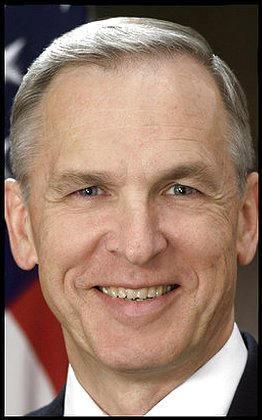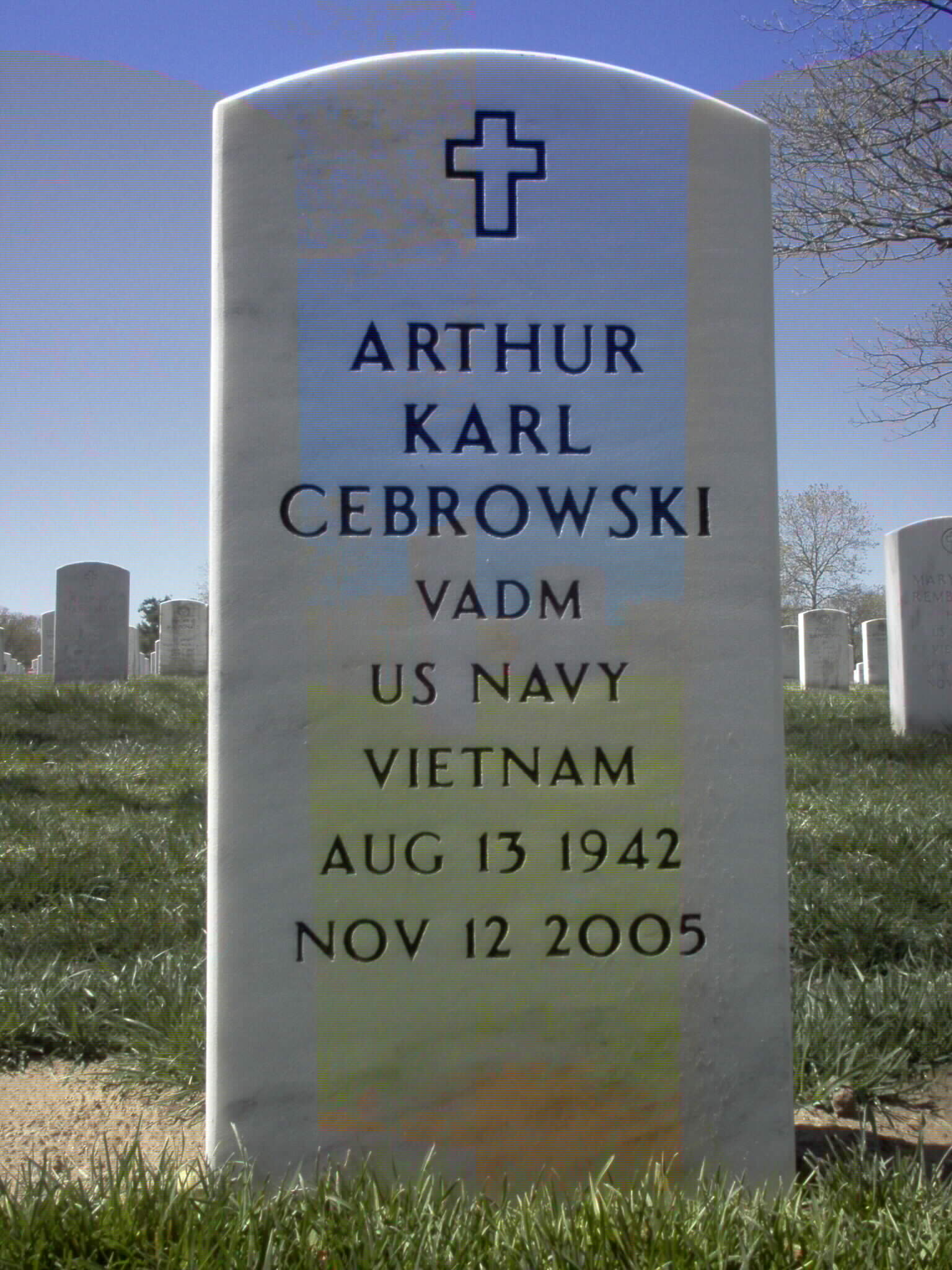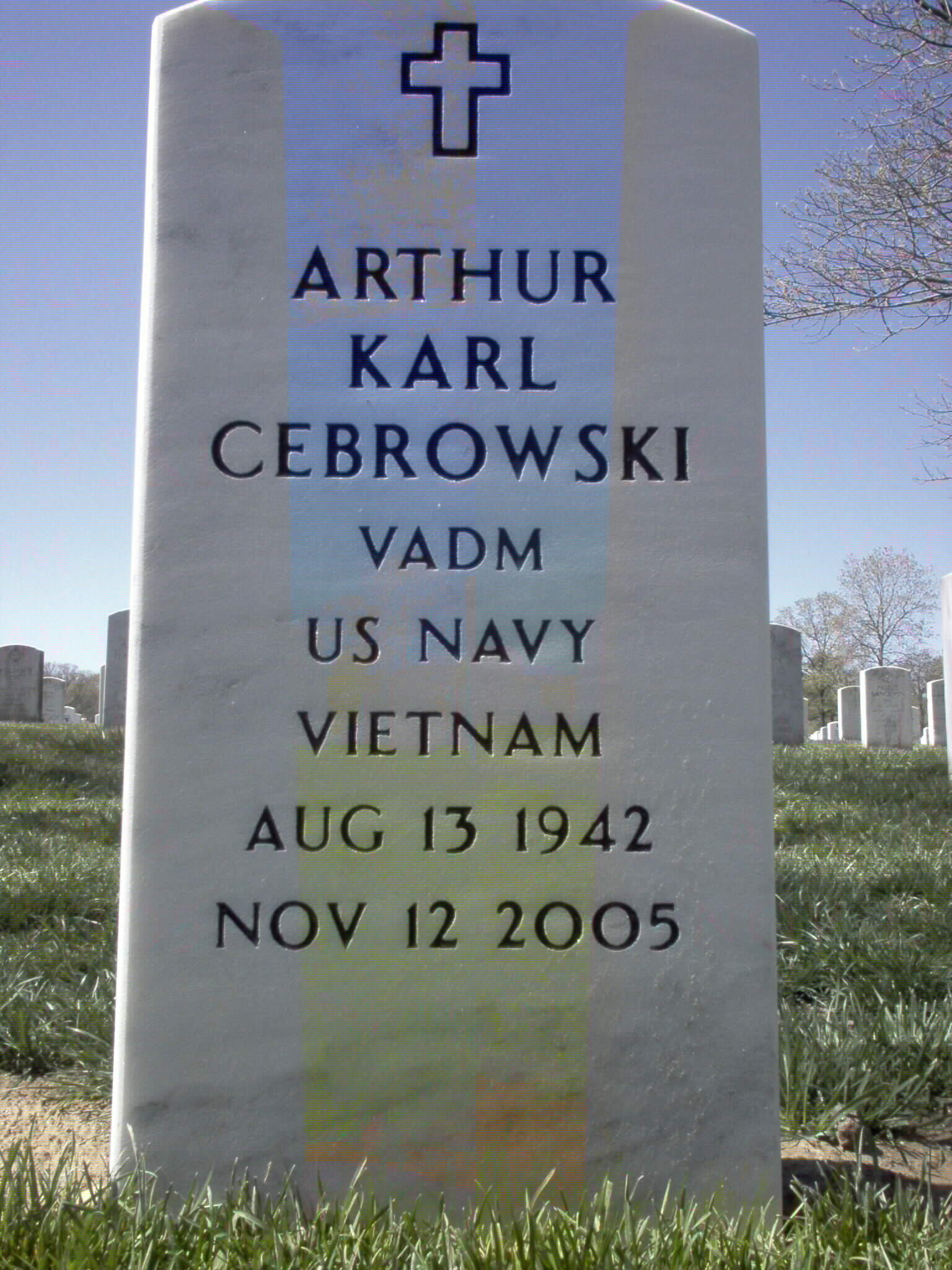Admiral Arthur Cebrowski Dies; Led Pentagon Think Tank
By Adam Bernstein
Courtesy of the Washington Post
Tuesday, November 15, 2005
Arthur K. Cebrowski, 63, a retired Navy Vice Admiral who became the first leader of a Pentagon office working to transform military thinking about future readiness and combat needs, died November 12, 2005, at the National Naval Medical Center in Bethesda, Maryland. He had cancer.
Admiral Cebrowski began his military career in 1964 and, as a naval aviator, flew 154 combat missions during three years in Vietnam. He held a variety of command posts, and his career came to encompass extensive work in strategy.

As president of the Naval War College in Newport, Rhode Island, from 1998 to 2001, he argued against the expensive, heavily manned ships of the Cold War in favor of agile, smaller vessels that could far better “baby-sit the petri dish of festering problems we have around the world.”
At the war college, his final active-duty assignment, he helped promote the concept of the Streetfighter ship that came with an ejectable escape pod for its crew. This notion was part of his focus on building a newer generation of vessels, such as the “littoral combat ship,” which could patrol coastal waters but adapt to other circumstances.
His work attracted the attention of Defense Secretary Donald H. Rumsfeld, who selected Admiral Cebrowski after his Navy retirement to direct the new Office of Force Transformation. Rumsfeld started the office as a form of think tank, designed to help the military accent speed and information-age technologies as it confronted terrorists and unstable countries more frequently.
One project involved the use of small satellites to aid troops on front lines and others in the field of combat who needed photos immediately. This was an example of what he called “network-centric warfare,” a concept focused on uniting ships, aircraft, satellites and ground forces in effective and speedy ways.
Andrew Krepinevich Jr., a retired Army Lieutenant Colonel who is now Executive Director of the Center for Strategic and Budgetary Assessments, a defense research organization in Washington, said Adm. Cebrowski’s goal at the Pentagon was changing civilian and military attitudes about an entire approach toward combat.
Krepinevich said Admiral Cebrowski had some successes during his short time as director, among them getting the Navy to start funding his littoral combat ships program. Also, he said, the idea of network-centric warfare “has been widely accepted, at least verbally.”
The Admiral, a Warrenton resident, retired from his civilian Pentagon position in January because of ill health.
Arthur Karl Cebrowski was born in Passaic, New Jersey, on August 13, 1942, and was a 1964 mathematics graduate of Villanova University. He received a master’s degree in computer systems management from the Naval Postgraduate School in Monterey, California, and attended the Naval War College.
He commanded the aircraft carrier Midway during the Persian Gulf War.
His decorations included the Distinguished Service Medal, five awards of the Legion of Merit, the Bronze Star, two awards of the Meritorious Service Medal, 10 awards of the Air Medal and two awards of the Navy Commendation Medal with combat “V.” He also was a recipient of the Navy League’s John Paul Jones Award for leadership.
Survivors include his wife, Kathryn Prezzano Cebrowski of Warrenton; two daughters, Kristin Niro of Little Silver, New Jersey, and Julie Clark of Caldwell, West Virginia; his parents, John and Helen Cebrowski of Hasbrouck Heights, New Jersey; a brother; a sister; and seven grandchildren.
CEBROWSKI, ARTHUR K., VADM USN (Ret.)
On November 12, 2005 at age 63. Beloved husband of Kathryn M. Cebrowski of Warrenton, Virginia; devoted father of Kristin Niro of Little Silver, New Jersey, and Julie Clark of Caldwell, West Virginia. Loving son of John and Helen Cebrowski of Hasbrouck Heights, New Jersey; dear brother of John W. Cebrowski of Bedford, New Hampshite and Carol Cebrowski of Hasbrouck Heights, New Jersey; cherished grandfather of seven, Courtland, Mikayla, Analeese, Matthew, Emma, Grace and Caroline.
Family will receive friends this evening from 7 to 9 p.m. at MOSER FUNERAL HOME, 233 Broadview Ave., Warrenton, Virginia. Mass of Christian Burial will be offered at St. John the Evangelist Catholic Church, 271 Winchester St., Warrenton, on Tuesday at 10:30 a.m. Interment with Full Honors at a later date at Arlington National Cemetery.
In lieu of flowers, memorial contributions may be made to the American Life League, P.O. Box 1530, Stafford, Virginia 22555.
Commentary: The Cebrowski revolution
By Arnaud de Borchgrave
UPI Editor at Large
Published January 18, 2006
Basil H. Liddell Hart was long considered one of the world’s foremost military thinkers – a man many experts regarded as the “Clausewitz of the 20th century.” What Clausewitz was to war, Sun Tzu was to “The Art of War” 25 centuries ago. And what Mao Zedong was to guerrilla warfare, Admiral Arthur K. Cebrowski was to Net-centric warfare.
Ten years ago, who could have imagined an aircraft cockpit at CIA headquarters at Langley, Virginia, with a pilot flying an unmanned Predator aircraft over the Afghan-Pakistani border and next to him a bombardier firing a guided missile or bomb on an al-Qaida target – all done in nanoseconds by commands that go up to a satellite in stationary orbit 22,300 miles above earth and down to the Predator? The next stage will be to take the pilot out of the cockpit and fly unmanned fighter-bomber sorties and long-range bombing missions thousands of miles away by remote control from the Pentagon.
Cebrowski saw this entirely new world coming – and much more. He was the Pentagon’s driving force for change with the title of director of the Office of Force Transformation. His 25-strong team came up with Humvees that combine pain rays with regular guns, and battleship blimps for hauling military cargo.
He lost a long battle with cancer last November and, as a friend and admirer, we recently attended his official funeral with full military honors at Arlington National Cemetery. The 63-year-old transformation czar, after 37 years in the Navy, has already found his place in military history.
In his 1998 Naval Proceedings seminal article – “Network-Centric Warfare: Its Origin and Future” – Cebrowski described a revolutionary transformation for military thinkers the world over. His understanding of the business world, technology and complexity led him to see how forces should train, organize, equip and fight differently. U.S. forces were already doing what Cebrowski prescribed.
Britain’s new defense acquisition plan by Lord Drayson refers to the speed of the U.S. change and the need to keep pace. The Brits call it “Network Enabled Capability.” Singapore and Sweden have already adopted NCW and almost all modern militaries have set similar goals.
At graveside in Arlington, foreign military attaches, including a Japanese vice admiral, came up to Kathy Cebrowski to tell her how much her husband’s work had influenced their thinking. Cebrowski’s influence on military establishments from Moscow to Madrid and from Seoul to Sydney has been enormous. Entire organizations are undergoing radical change to reflect the ideas put forth in a now eight-year-old article.
Network-centric rather than platform-centric warfare means radical changes in how forces train, organize and allocate resources. On “Intellectual Capital,” Cebrowski wrote, “Information-based processes are the dominant value-adding processes in both the commercial world and the military. Yet the military fails to reward competence in these areas. ‘Operator’ status is frequently denied to personnel with these critical talents, but the value of traditional operators with little acumen in these processes is falling, and ultimately they will be marginalized, especially at mid-grade and senior levels.”
The Cebrowski revolution is producing a new elite that is rapidly superseding the conventional war fighter. The admiral liked to quote B.H. Liddell Hart who said, “The only thing harder than getting a new idea into the military mind is getting an old one out.”
The Admiral, a naval aviator who racked up 150 combat missions in Vietnam and went on to command the aircraft carrier USS Midway and the USS America Battle Group, said, “Every soldier, every drone, and every general should be linked together into a giant Internet for combat.” Today, Cebrowski’s vision is almost a reality.
Cebrowski identified the need to move “disruptive technology” more quickly into the hands of those doing the fighting. While already battling cancer, he pushed innovative and still secret equipment and tools to the troops for operational experimentation during the war on terrorism.
Prior to taking over as transformation czar, Cebrowski was president of the Naval War College in Newport, R.I., where he inculcated his vision to shape a new generation of leaders. It was a vision based on combat experience in Vietnam and in Desert Storm.
“It’s frequently said you cannot predict the future,” he liked to say, “but, in fact, we know a great deal about the future. There are perfectly predictable surprises, so also are there opportunities for leaders to make things change. And the great burden for leaders in this time is to recognize the inevitable and turn it into a virtue.”
Ignored for a few decades, Rear Admiral William A. Moffett eventually became known as the father of naval aviation. Admiral Hyman G. Rickover was recognized as the father of the nuclear Navy. Vice Admiral Arthur K. Cebrowski will become known as the father of a network-centric military.
As one of his eulogizers concluded, “Students of warfare and peacemaking will study his ideas and marvel at his contributions for decades to come.”
Sometimes it is only with the passage of time and history that greatness is recognized fully. Cebrowski joined the ranks of history’s great military thinkers while he was still alive.
Michael Robert Patterson was born in Arlington and is the son of a former officer of the US Army. So it was no wonder that sooner or later his interests drew him to American history and especially to American military history. Many of his articles can be found on renowned portals like the New York Times, Washingtonpost or Wikipedia.
Reviewed by: Michael Howard


